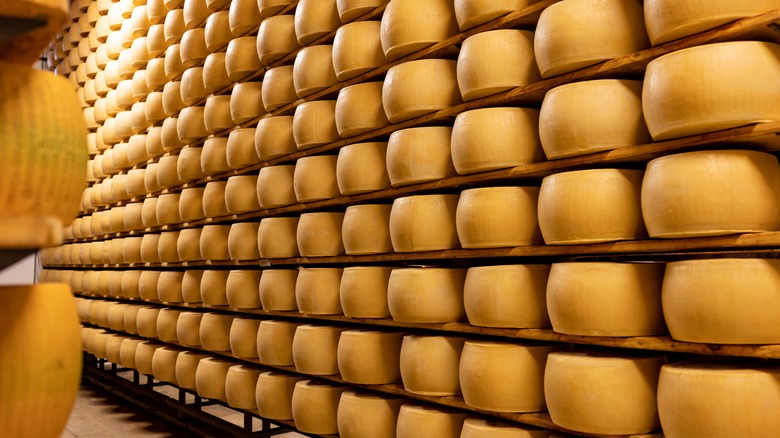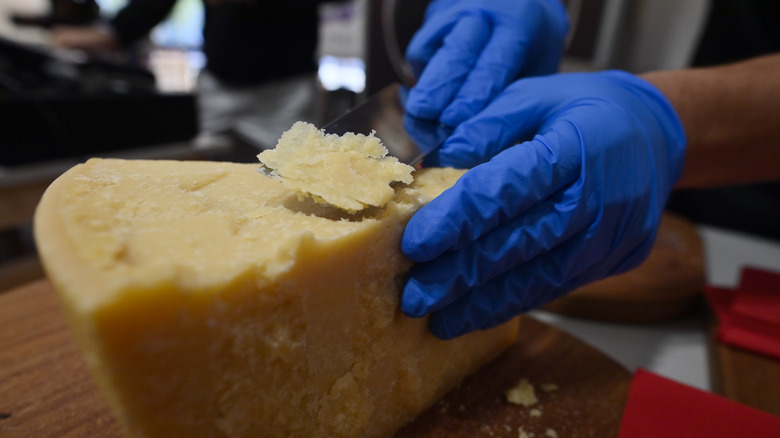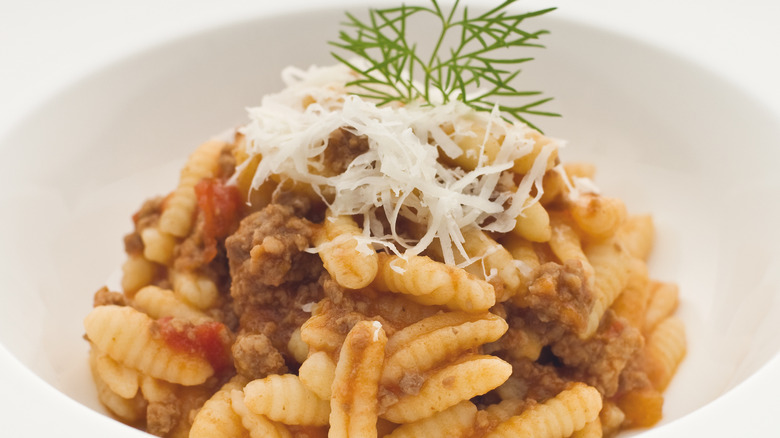The Age Of Parmesan Will Dictate What It Tastes Like
It may come as no surprise that the parmesan you find in the plastic shaker at the grocery store is far removed from the versatile, gustatory experience that is Parmigiano Reggiano. Like many kinds of cheese, the popularity of parmesan has led to extensive processing and adulteration. Ponder the difference between a sharp, crumbly, bitey cheddar and the smooth store-bought slab; bland and plasticky deli Swiss and its real, nutty counterparts; and, of course, the delicious but dubious American cheese that has to be labeled a "pastured processed cheese food."
The parmesan many of us grew up showering onto spaghetti comes with cellulose and other additives and pales in comparison to the genuine article. Parmigiano Reggiano can only be produced in Parma, Italy, from the raw milk of grass-fed cattle (per Castello). A wheel of the stuff is accordingly tattooed to indicate its origin (per Core77). This type of parmesan can be eaten on a cheese plate and exhibits deep, rich, savory flavors. Trader Joe's describes its 40-month Parmigiano Reggiano as buttery and fruit-scented, and Castello praises notes of nuttiness and salt. The complex, tantalizing taste of parmesan develops as it ages, and science explains why.
Older, wiser, and tastier
According to Parmigiano Reggiano USA, this King of Cheeses undergoes a lengthier aging process than its cheesy constituents. All that time promotes the appearance of subtle, signature flavors and aromas. Wisconsin Cheese explains that aged cheese has less moisture and higher concentrations of desired bacteria and enzymes that perform natural alchemy to create the tasting experience we crave. In addition to Parmigiano Reggiano, you'll observe similar forces at work in asiago, blue cheese, gouda, gorgonzola, alpine-style cheeses, and true cheddars, Wisconsin Cheese continues.
You might also notice that aged parmesan has crunchy little crystals in it. This is the salt calcium lactate, which occurs due to lactose (milk sugar) and calcium undergoing chemical changes as the cheese matures, per Good Food. Another hallmark of parmesan's flavor is the amino acid tyrosine, present in milk's protein casein, which also crystallizes — waking up our umami taste receptors, Good Food adds. The longer the cheese is aged, the tastier it will become.
The real way to eat parmesan
Insider reports that parmesan cheese is a significant source of revenue for Italy — a $2.5 billion industry. It adds that a big wheel can fetch more than a thousand dollars, though you can get a two-year-old one at Costco for $899 (via Marketwatch). In 2022, Parmigiano Reggiano ran a TV ad in the United Kingdom with chef Gennaro Contaldo, who is proud to stand behind the cheese's unparalleled culinary qualities. Parmesan cheese is a celebrity unto itself. Just ask the likes of Ina Garten with her parmesan chicken and Alton Brown — who cuts to the chase and bakes parmesan into irresistible chips.
So what else can you do with this incredible stuff? Enjoy a shred of thinly-shaved parmesan with fruit, balsamic glaze, and charcuterie. Grate it onto your red sauce or roast vegetable dishes. Use it in comfort food recipes like parmesan au gratin potatoes. When you're done with the wedge, save that rind for sauces, soups, and broths. Parmesan is worth its weight in gold, and there are many ways to enjoy this regal, unique cheese.


